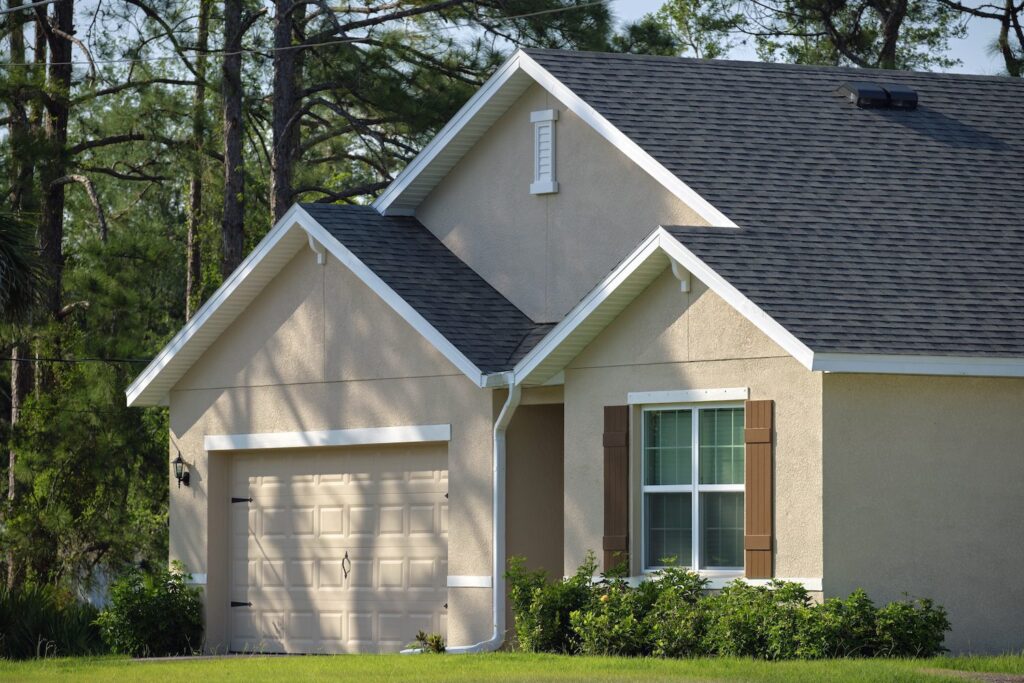Stucco house exterior is a common sight in mountain foothill communities like some of those surrounding Atlanta. It offers a timeless look, durability, and energy efficiency, and while it holds up well in many conditions, the region’s humidity, storms, and shifting soil can cause wear over time.
However, with proper care, stucco can stay strong and attractive for decades. This post will guide you through everything from the relationship between stucco and climate to general tips for keeping your home\’s exterior appealing.
Climate, Geography, & Stucco Compatibility
Stucco performs well in many environments, but regions with mountain foothills can bring unique challenges.
The combination of humid summers, heavy rainfall, and occasional temperature swings can take a toll on exterior materials, including stucco.
- High humidity and rain can lead to moisture absorption, which may cause cracks, discoloration, or even mold growth if not properly sealed.
- Storms and wind exposure can wear down stucco over time, especially if water gets into small cracks and expands with temperature changes.
- Soil shifts and foundation settling can create structural movement, which may lead to noticeable cracks or uneven stucco surfaces.
Despite these challenges, stucco remains a great option for a house in a mountain or foothill region. In recent years, stucco has been one of the most common siding materials in GA, used on 28% of new single-family homes. Its insulating properties help regulate indoor temperatures, and with proper maintenance, it can last for decades without major repairs.
Stucco Maintenance Musts
- Keep stucco properly sealed to protect it from moisture. Waterproofing treatments should be applied every few years, especially in areas exposed to heavy rain.
- Clean the stucco gently using a soft-bristle brush or a low-pressure hose. Harsh power washing can cause damage, so it’s best to avoid high-pressure settings.
- Check gutters and downspouts to ensure water is directed away from stucco walls. Pooling water near the foundation can lead to moisture problems.
- Trim nearby trees and shrubs to prevent physical damage and reduce moisture buildup near the walls.
Pro Tips for Stucco Longevity
Your Sealant Type and Timing
Stucco needs a breathable waterproofing product to repel moisture while allowing trapped water to escape. Sealing stucco every few years adds a protective barrier that helps prevent water infiltration and surface wear.
The best time for application is early spring or fall when temperatures are moderate and humidity levels are stable.
Avoid sealing during extreme heat or after heavy rain, as improper curing can trap moisture beneath the surface.
Know the Subtle Signs of Moisture
Moisture-related damage often starts beneath the surface, making it hard to detect until cracks, mold, or stains appear.
If stucco looks damp hours or even days after rainfall, or if dark streaks form near windows and doors, water may be seeping in through unsealed areas.
Addressing these signs early—through proper sealing, improved drainage, or caulking gaps—helps prevent costly repairs and structural issues.
Patch Hairline Cracks ASAP
Hairline cracks are normal, but if left untreated, they can widen and allow moisture in. Using a stucco patching compound on minor cracks prevents water infiltration and further damage.
For cracks wider than ⅛ inch, a professional inspection is recommended, as this may signal foundation movement or deeper structural issues.
Check Your Seals
Stucco damage often starts where water finds its way in—especially around windows, doors, vents, and rooflines.
Over time, caulking can shrink, crack, or peel, allowing moisture to seep into stucco and cause internal damage. Reapplying high-quality exterior caulk every few years helps keep these vulnerable areas sealed and protected.
Watch the Foundation
Shifting soil is common in Georgia’s foothills, which can lead to foundation settling and stress on walls. Signs of movement include widening cracks, separation between stucco panels, or uneven surfaces.
If you notice these issues, a foundation inspection may be necessary to prevent structural damage that could impact the entire home.
Proactive maintenance helps stucco homes withstand climates like ours, preventing common issues like water damage, cracking, and mold.
Other Home Exterior Care
- Gutters and drainage – Keep gutters and downspouts clear to prevent water from pooling near stucco walls. Redirect runoff away from the foundation.
- Foundation checks – Small foundation shifts can lead to stucco cracks and structural stress. If doors or windows start sticking, it may be time for an inspection.
- Attic ventilation – Good airflow inside the home helps reduce humidity buildup that can impact stucco over time.
- Exterior paint and sealant upkeep – Painted stucco or protective coatings help shield against moisture absorption. Reapply as needed to maintain protection.
Signs of Wear on Stucco
- Cracks – Hairline cracks are common, but wider or spreading cracks may indicate foundation movement or moisture damage beneath the surface.
- Water stains and mold – Dark streaks, green patches, or discoloration near windows and rooflines suggest water is seeping behind the stucco.
- Chipping or flaking – Small chips may seem minor, but they often signal underlying moisture issues or improper installation.
- Bubbling or bulging areas – Stucco that looks swollen or feels soft to the touch usually means water is trapped beneath the surface.
- White, chalky residue (efflorescence) – A powdery white film on stucco indicates water is evaporating through the surface and leaving behind minerals.
When to Call a Professional
- Cracks are widening, deepening, or spreading across large areas
- Stucco is detaching, crumbling, or exposing damage underneath
- Mold, mildew, or staining keeps coming back despite regular cleaning
- You’re buying or selling a stucco home and need a professional inspection
Conclusion
Stucco is a durable and attractive choice for house exteriors near mountain foothill regions, but it needs proper care to withstand the climate. With routine TLC, moisture control, and preventative maintenance, homeowners keep their exteriors looking great.
If you notice signs of stucco damage or want to make sure your home is in the best shape possible, a professional inspection can help—Champia has you covered.
